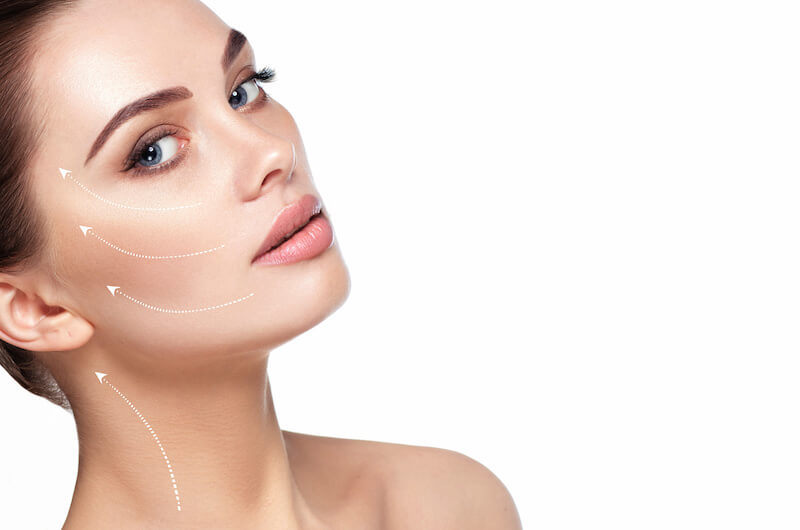
Facial Volumetry with Hyaluronic Acid – Nowa Estetyka Wrocław
Shaping facial contours without surgery
Facial Volumetry – Indications
As the aging process progresses, facial muscles weaken, skin becomes lax, and subcutaneous fat tissue (fat pads) gradually diminishes, especially in areas like the cheekbones, zygomatic arch, and temples. This volume loss allows the skin to sag due to gravity, deepening wrinkles and folds such as nasolabial folds, marionette lines, and smoker’s lines (above the upper lip). These effects are part of the “pyramid of aging,” where the face takes on an inverted V shape. The thin skin around the eyes reveals hollows and shadows in the “tear trough” area, giving the face a sad, tired appearance and making signs of fatigue more apparent.
Volumetric lifting restores lost tissue volume, making the face appear fuller and reversing visible signs of aging. Hyaluronic acid facial volumetry can be used to enhance facial contours, fill in the temples and cheekbones, and improve the jawline.
Volumetry with Platelet-Rich Fibrin
Platelet-Rich Fibrin (i-PRF) is a natural filler material that also accelerates tissue regeneration and healing processes. Mesotherapy with platelet-rich stem cells provides a volumetric effect lasting 3-4 weeks, which is why 3-4 treatments are recommended at intervals of several weeks. Platelet-rich fibrin also visibly improves skin elasticity and nourishment, smoothing wrinkles.
Before the Procedure
Specialized diagnostics are not required before facial volumetry with hyaluronic acid. Patients should avoid anti-inflammatory medications, blood thinners, vitamin E, and aspirin for 3 days prior to the procedure. Alcohol should not be consumed immediately before the treatment, as dilated blood vessels may cause increased bleeding. Exposure to UV radiation should also be minimized.
The Procedure
During the first consultation, the specialist will identify the patient’s concerns and create a comprehensive treatment plan. As with other injection treatments, an anesthetic gel is applied to the skin 30 minutes before the injections. The volumetry procedure itself takes just over 15 minutes. Unlike plastic surgery, facial volumetry with hyaluronic acid does not require downtime. In rare cases, mild bruising and sensitivity at the injection site may occur, despite the use of microcannulas. These are the only side effects of hyaluronic acid volumetry, and they usually resolve on their own.
Volumetry – Results
Hyaluronic acid replenishes soft tissue volume, providing the following results:
- More defined facial contours
- Improved facial oval
- Attractively shaped cheekbones
- Firm and elastic skin
- Reduction of tear trough hollows
- A more youthful facial appearance
- Correction of facial asymmetry
In addition to restoring attractive facial proportions, hyaluronic acid volumetry also provides a gentle facelift by lifting the corners of the mouth, sagging cheeks, and the jawline (marionette lines). Age-sharpened facial features regain a youthful look.
When Are the Results Visible?
Volumetry provides an immediate improvement in facial contours, volume, and skin tension. Depending on the filler composition, further wrinkle reduction occurs within a few days after the treatment. Final results are assessed 2-3 weeks later during a follow-up visit.
How Long Does Hyaluronic Acid Last in the Skin?
The effects of hyaluronic acid volumetry last 10-12 months. Hyaluronic acid, which is almost identical to the natural hyaluronic acid found in the body, is gradually absorbed. The duration of results depends not only on the product used but also on the patient’s individual factors, skin type, lifestyle, and physical activity.
Is Volumetry Safe?
Since hyaluronic acid naturally occurs in the body, injections with synthetic hyaluronic acid-based fillers are completely safe aesthetic treatments. There are no allergic reactions, and the most common side effects—mild swelling and tenderness—resolve within a few days.
Post-Treatment Recommendations
After facial volumetry, avoid extreme temperatures (sauna, tanning beds, swimming pools, cold wind) for a few days. Daily skincare routines should be performed gently, avoiding rubbing or stretching the skin. Since injections break the skin barrier, activities that increase the risk of infection (such as touching the skin or applying makeup) should be avoided. It is recommended to refrain from intense physical exercise.
Contraindications
- Allergy to polylactic acid or hyaluronic acid
- Skin inflammation: acne, active herpes
- Cancer
- Tendency to develop hypertrophic scars
- Volumetry should not be performed during menstruation
- Pregnancy and breastfeeding